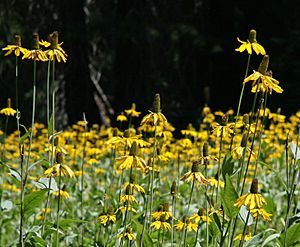California coneflower facts for kids
Quick facts for kids California coneflower |
|
|---|---|
 |
|
| Meadow of Rudbeckia californica flowers | |
| Scientific classification | |
| Genus: |
Rudbeckia
|
| Species: |
californica
|
Rudbeckia californica is a beautiful flowering plant often called the California coneflower. It belongs to the Asteraceae family, which is a big group of plants that includes sunflowers and daisies. This plant is known for its tall stems and bright yellow flowers that look a bit like a cone.
Contents
Where it Lives
The California coneflower is a plant that loves to grow in California. You can find it in the Sierra Nevada mountains, the Klamath Mountains, and along the northern coast. It especially likes wet places, such as sunny mountain meadows and the banks of streams.
How it Grows
This plant is a tall, straight plant that comes back year after year. It grows from a thick underground stem called a rhizome, which helps it spread. The main stem can grow very tall, sometimes reaching almost two meters (about 6.5 feet) high! It usually grows straight up without many branches.
Its Leaves
Most of the California coneflower's big leaves grow from the bottom of the plant, near the ground. A few other leaves are spaced out along the stem. These leaves can be as long as 30 centimeters (about 12 inches). They are shaped like a spear or an oval, and their edges can be smooth or slightly wavy.
Its Flowers and Seeds
The flower of the California coneflower looks a lot like a sunflower. It usually has one large flower head on each stem. The base of the flower head can be up to 6 centimeters (about 2.4 inches) wide.
The Petals
The bright yellow "petals" you see are actually called ray florets. There are several of these, and each one is about 2 to 6 centimeters long. They first stick out from the center, then bend backward, pointing down along the stem.
The Center
The middle part of the flower head is filled with many small, greenish-yellow flowers called disc florets. This center part can be shaped like a button, a cone, or even a cylinder.
The Seeds
After the flower blooms, it produces small fruits called achenes. These are basically the plant's seeds, and each one is about half a centimeter long. They have a small tuft of scales on top, which is called a pappus.

